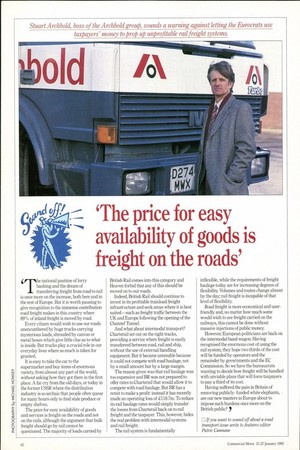The price for easy availability of goods is freight on the roads'
Page 44

If you've noticed an error in this article please click here to report it so we can fix it.
T ( he national pastime of lorry bashing and the dream of transferring freight from road to rail is once more on the increase, both here and in the rest of Europe. But it is worth pausing to give recognition to the immense contribution road freight makes in this country where 89% of inland freight is moved by road.
Every citizen would wish to use our roads unencumbered by huge trucks carrying mysterious loads, shrouded by canvas or metal boxes which give little clue as to what is inside. But trucks play a crucial role in our everyday lives where so much is taken for granted.
It is easy to take the car to the supermarket and buy items of enormous variety, from almost any part of the world, without asking how they got there in the first place. A far cry from the old days, or today in the former USSR where the distribution industry is so archaic that people often queue for many hours only to find stale produce or empty shelves.
The price for easy availability of goods and services is freight on the roads and not on the rails, although the argument that bulk freight should go by rail cannot be questioned. The majority of loads carried by British Rail comes into this category and Heaven forbid that any of this should be moved on to our roads.
Indeed, British Rail should continue to invest in its profitable trainload freight infrastructure and seek areas where it is best suited—such as freight traffic between the UK and Europe following the opening of the Channel Tunnel.
And what about intermodal transport? Charterail set out on the right tracks, providing a service where freight is easily transferred between road, rail and ship, without the use of external handling equipment. But it became untenable because it could not compete with road haulage, not by a small amount but by a large margin.
The reason given was that rail haulage was too expensive and BR was not prepared to offer rates to Charterail that would allow it to compete with road haulage. But BR has a remit to make a profit instead it has recently made an operating loss of £118.7m. To reduce its rail haulage rates would simply transfer the losses from Charterail back on to rail freight and the taxpayer. This, however, hides the real problem with intermodal systems and rail freight.
The rail system is fundamentally inflexible, while the requirements of freight haulage today are for increasing degrees of flexibility. Volumes and routes change almost by the day; rail freight is incapable of that level of flexibility.
Road freight is more economical and userfriendly and, no matter how much some would wish to see freight carried on the railways, this cannot be done without massive injections of public money.
However, European politicians are back on the intermodal band wagon. Having recognised the enormous cost of using the rail system, they hope two thirds of the cost will be funded by operators and the remainder by governments and the EC Commission. So we have the bureaucrats wanting to decide how freight will be handled with unviable plans that will force taxpayers to pay a third of its cost Having suffered the pain in Britain of removing publiclyfunded white elephants, are our new masters in Europe about to impose such burdens once more on the British public?
If you want to sound off about a road transport issue write to features editor Patric Cunnane












































































